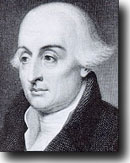
|
Joseph LaGrange, an 18th century French mathematician, was the first person to prove that every positive integer is
expressible as a sum of four or fewer square numbers. This is known as Lagrange's Four Square Theorem.
|
Express the following positive integers as the sum of four or fewer squares to illustrate LaGrange's Four Square Theorem. Some numbers have more than one representation. Watch for emerging patterns.
| 1 = | 13 = | 25 = |
| 2 = | 14 = | 26 = |
| 3 = | 15 = | 27 = |
| 4 = | 16 = | 28 = |
| 5 = | 17 = | 29 = |
| 6 = | 18 = | 30 = |
| 7 = | 19 = | 48 = |
| 8 = | 20 = | 56 = |
| 9 = | 21 = | 77 = |
| 10 = | 22 = | 87 = |
| 11 = | 23 = | 92 = |
| 12 = | 24 = | 114 = |
1. Which of the integers from 10 to 20 have more than one representation when expressed
as the sum of four or fewer squares?
2. Attempt to write each of the integers from 1 to 20 as a sum of three or fewer squares.
For which of these numbers can this not be done?
3. Express the year you were born as a sum of four or fewer squares.
SQUARE NUMBERS
|
|---|